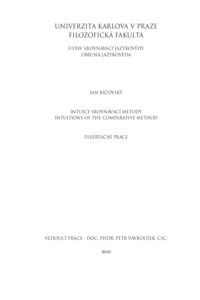Intuice srovnávací metody
The Intuitions of the Comparative Method
dizertační práce (OBHÁJENO)

Zobrazit/
Trvalý odkaz
http://hdl.handle.net/20.500.11956/34644Identifikátory
SIS: 101249
Katalog UK: 990013624810106986
Kolekce
- Kvalifikační práce [24984]
Autor
Vedoucí práce
Oponent práce
Kurzová, Helena
Pultrová, Lucie
Fakulta / součást
Filozofická fakulta
Obor
Obecná lingvistika
Katedra / ústav / klinika
Ústav srovnávací jazykovědy
Datum obhajoby
18. 5. 2011
Nakladatel
Univerzita Karlova, Filozofická fakultaJazyk
Čeština
Známka
Prospěl/a
Cílem disertační práce je identifikovat a vysvětlit slabá místa - "slepé skvrny" srovnávací metody a metody vnitřní rekonstrukce, tak jak se uplatňují v tradiční historické lingvistice, zejména v indoevropeistice. Jak v jazyce, tak i ve vědě se může jako nejlepší ukázat vysvětlení historické - proto zde stručně shrnuji vývoj metod od předvědědeckého období k pozdnímu strukturalismu a současnému stavu na počátku 3. tisíciletí. Ukazuje se, že se tyto metody zakládají na téže intuici, která slouží mluvčím k osvojování jazyka a tím pádem jsou náchylné k jednostrannosti, jež je užitečná pro mluvčí, ale vede k pomíjení případných kontraintuitivních řešení. Také původní účel metod byl odlišný od jejich dnešního uplatnění a nadále trvá debata, zda je rekonstrukt prajazyka cosi víc než jen formule, zkratka pro množiny korespondencí či zda jde o skutečnýž jazyk, jejž je možné popisovat/rekonstruovat stejným způsobem, třebaže s menší jistotou, jako kterýkoli živý jazyk. Formalistický jazyk je abstraktní systém a z pohledu historické lingvistiky (o čemž níže) to vlastně není jazyk a neposkytuje jakékoli uspokojivé vysvětlení toho, jak se jazyky vyvinuly do odlišné podoby, nanejvýš poskytuje prostředek kódování je dekódování jednoho jazyka v druhý, k čemuž není vhled do mechanismu vývoje nezbytný. Historické...
The thesis aims to identify and explain the weak - the "blind" spots of the Comparative Method and Internal Reconstruction as they are used in the traditional historical linguistics, the prime example of which is Indo-European linguistics. As in language, even in science the best explanation may be the historical one - here the development of the method is followed briefly from the pre-scientific era up to late structuralism and the state-of-the- art of the 3rd millennium. It appears clear that the methods are based mostly on the same intuitions that serve the speaker to acquire any language and are prone to have biases that are useful for speakers but tend to ignore certain solutions that are counter-intuitive. The original aim of the methods was quite different from what it is now - and the debate still continues as to whether the proto-language is anything more than a formula, a short- hand for sets of correspondences or whether it is a real language which we may perhaps describe in the same manner, though with less certainty, than any living language. The formulaist language is abstract and from the point of historical linguistics (see bellow) not a language at all and provides no interesting explanation of how the languages came to be different beyond providing a means of encoding and decoding...
